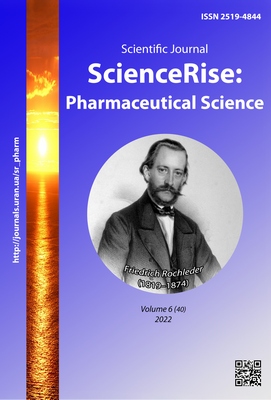Визначення гіпоглікемічних властивостей таблеток «Гліфасонорм» і капсул «Гліфасолін» на моделі стрептозотоцинового діабету у щурів
DOI:
https://doi.org/10.15587/2519-4852.2022.271034Ключові слова:
стрептозотоциновий діабет, гіпоглікемічна активність, глікозильований гемоглобін, метформін, таблетки «Гліфасонорм», капсули «Гліфасолін»Анотація
Ризик розвитку будь-яких ускладнень при цукровому діабеті значно знижується шляхом контролю та відповідної корекції рівня глюкози в крові та артеріального тиску, а також дотримання правил здорового способу життя. Раннє виявлення та лікування цукрового діабету 2-го типу сприяє попередженню прогресування захворювання та розвитку ускладнень.
Мета. Вивчення гіпоглікемічної активності таблеток «Гліфасонорм» і капсул «Гліфасолін» на моделі стрептозотоцинового діабету у щурів.
Матеріали та методи. Дослідження проведені на щурах лінії Вістар, яким внутрішньочеревно вводили нікотинамід, в дозі 230 мг/кг маси тіла за 15 хвилин до внутрішньовенної ін’єкції стрептозотоцину в дозі 65 мг/кг. Досліджували динаміку маси тіла щурів, показники вмісту глюкози та глікозильованого гемоглобіну під впливом тривалого введення метформіну, таблеток «Гліфасонорм» і капсул «Гліфасолін».
Результати та їх обговорення. Проведені дослідження на експериментальній моделі стрептозотоцинового діабету встановили, що під дією таблеток «Гліфасонорм» і капсул «Гліфасолін» вірогідно знижувався рівень глікозильованого гемоглобіну, що знижувався разом з рівнем глюкози в крові тварин у порівнянні з діабетичним контролем. Через 14 діб дослідження капсули «Гліфасолін» проявили більш виразну гіпоглікемічну активність (на 4,4 % і на 8,0 % більшу), ніж таблетки «Гліфасонорм» і препарат порівняння метформін. Під дією капсул «Гліфасолін» на 12 добу дослідження встановлено виразне зниження глікозильованого гемоглобіну в крові тварин (на 3,1 % і на 5,6 % більше), ніж у таблеток «Гліфасонорм» і метформіну.
Висновки. На експериментальній моделі стрептозотоцинового діабету у щурів капсули «Гліфасолін» проявили більш виразний гіпоглікемічний ефект, що проявлявся зниженням вмісту глікозильованого гемоглобіну в крові і переважали дію препарату порівняння метформіну та таблеток «Гліфасонорм».
Капсули «Гліфасолін» і таблетки «Гліфасонорм» на основі біофлавоноїдного комплексу з квасолі є перспективними у терапії ЦД 2-го типу на тлі ожиріння і зниженні ризику розвитку мікро- і макроангіопатій
Посилання
- Nathan, D. M., Buse, J. B., Davidson, M. B. et al. (2009). Medical management of hyperglycemia in type 2 diabetes: a consensus algorithm for the initiation and adjustment of therapy: a consensus statement of the American Diabetes Association and European Association for the Study of Diabetes. Diabetes Care, 32. doi: https://doi.org/10.2337/dc09-0271
- Rybak, V. A., Maloshtan, L. M. (2014). Vykorystannia bioflavonoidnoho kompleksu z kvasoli dlia likuvannia metabolichnoho syndromu na tli ozhyrinnia. Inform. lyst pro novovvedennia v systemi okhorony zdorov’ia No. 279. Kyiv, 35, 4.
- Dedov, I. I., Shestakova, M. V. (2003). Sakharnyi diabet. Moscow, 455.
- Dedov, I. I., Shestakova, M. V. (Eds.) (2009). Algoritm spetcializirovannoi meditcinskoi pomoshchi bolnym sakharnym diabetom. Moscow, 103.
- Bogachev, V. Yu., Golovanova, O. V., Kuznetsov, A. N., Shekoayan, A. O. (2013). Bioflavonoids and their significance in angiology: focus on diosmi. Angiology and vascular surgery, 19 (1), 73–81.
- Rybak, V. A. (2014). Determination of the effective dose (ED50) of spissum bean extract with potential hypoglycemic propertie. Problemy ekolohichnoi ta medychnoi henetyky i klinichnoi imunolohii, 1 (121), 225–230.
- Rybak, V. A., Maloshtan, L. M., Poltorak, V. V., Krasova, N. S. (2015). Vplyv tryvaloho zastosuvannia hustoho ekstraktu kvasoli na dynamiku masy tila, masy fraktsii abdominalnoi zhyrovoi tkanyny u shchuriv z tsukrovym diabetom 2-ho typu na tli ozhyrinnia. Svit medytsyny ta biolohii, 2 (50), 172–175.
- Rieznykov, O. H. (2003). Zahalni etychni pryntsypy eksperymentiv na tvarynakh. Endokrynolohiia, 8 (1), 142–145.
- Stefanov, O. V. (Ed.) Doklinichni doslidzhennia likarskykh zasobiv. Kyiv: Avitsena, 528.
- Baynes, J. W. (1991). Role of oxidative stress in development of complications in diabetes. Diabetes, 40 (4), 405–412. https://doi.org/10.2337/diabetes.40.4.405
- Rybolovlev, Iu. R. (1979). Dozirovanie veshchestv dlia mlekopitaiushchikh po konstante biologicheskoi aktivnosti. Zhurnal AN SSSR, 247 (6), 1513–1516.
- Nazarenko, G. I., Kishkun, A. A. (2002). Klinicheskaia otcenka rezultatov laboratornykh analizov. Moscow: Meditcina, 544.
- Rybak, V. A., Maloshtan, L. M., Poltorak, V. V., Krasova, N. S. (2015). Vyvchennia antyoksydantnykh vlastyvostei hustoho ekstraktu kvasoli na modeli tsukrovoho diabetu 2-ho typu na tli ozhyrinnia v shchuriv. Farmakolohiia ta likarska toksykolohiia, 1 (42), 76–81.
- Patel A., MacMahon S., Chalmers J. et al. (2008). Intensive blood glucose control and vascular outcomes in patients with type 2 diabetes. New England Journal of Medicine, 358, 2560–2572. doi: https://doi.org/10.1056/nejmoa0802987
- Skyler, J. S., Bergenstal, R., Bonow, R. O., Buse, J., Deedwania, P., Gale, E. A. M. et al. (2009). Intensive Glycemic Control and the Prevention of Cardiovascular Events: Implications of the ACCORD, ADVANCE, and VA Diabetes Trials. Diabetes Care, 32 (1), 187–192. doi: https://doi.org/10.2337/dc08-9026
- Gerstein, H. C., Miller, M. E., Byington, R. P. et al. (2008). Effects of Intensive Glucose Lowering in Type 2 Diabetes. New England Journal of Medicine, 358 (24), 2545–2559. doi: https://doi.org/10.1056/nejmoa0802743
- Risk of hypoglycaemia in types 1 and 2 diabetes: effects of treatment modalities and their duration (2007). Diabetologia, 50 (6), 1140–1147. doi: https://doi.org/10.1007/s00125-007-0599-y
- Voloshin, O. I., Glubochenko, O. V., Pankiv, I. V., Glubochenko, V. G., Malkovich, N. M. (2021). Peculiarities of phytotherapy of diabetes mellitus through the prism of comorbidity and prevention of complications (review of literature). International Journal of Endocrinology (Ukraine), 15 (3), 258–267. doi: https://doi.org/10.22141/2224-0721.15.3.2019.172113
- Kurylo, Kh. I., Klishch, I. M., Volska, A. S., Barchuk, O. Z. (2016). Research of hypoglycemic properties of dry extract of vaccinium myrtillus L. Medical and Clinical Chemistry, 18 (2), 38–41. doi: https://doi.org/10.11603/mcch.2410-681x.2016.v0.i2.6669
- Kurylo, Kh. I., Klishch, I. M., Volska, A. S., Rozhkovskyi, Ya. V. (2020). Investigation of the influence of phytocompositions on the process of non-permanent glycosylation, activity of cytolytic processes, indicators of lipid exchange and lipid peroxidation balance in animal’s body in experimental diabetes. Medical and Clinical Chemistry, 4, 162–168. doi: https://doi.org/10.11603/mcch.2410-681x.2019.v.i4.10854
##submission.downloads##
Опубліковано
Як цитувати
Номер
Розділ
Ліцензія
Авторське право (c) 2022 Viktoria Rybak, Alexander Honcharov, Viktoriia Korol

Ця робота ліцензується відповідно до Creative Commons Attribution 4.0 International License.
Наше видання використовує положення про авторські права Creative Commons CC BY для журналів відкритого доступу.









